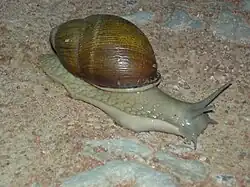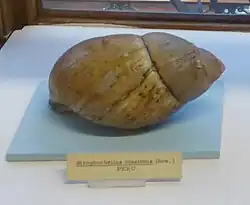Megalobulimus
| Megalobulimus | |
|---|---|

| |
| Megalobulimus parafragilior | |
| Scientific classification | |
| Kingdom: | Animalia |
| Phylum: | Mollusca |
| Class: | Gastropoda |
| Order: | Stylommatophora |
| Superfamily: | Rhytidoidea |
| Family: | Strophocheilidae |
| Genus: | K. Miller, 1878[1] |
| Type species | |
| Bulimus garciamoreni K. Miller, 1878 | |
| Synonyms | |
| |
Megalobulimus is a genus of air-breathing land snail, a terrestrial gastropod mollusk in the subfamily Megalobuliminae within the family Strophocheilidae (according to the taxonomy of the Gastropoda by Bouchet & Rocroi, 2005).[2]
Megalobulimus is the type genus of the subfamily Megalobuliminae.
Description
(Original description) The jaw and radula of the following species differ so considerably from those of the typical Borus oblongus Müll. that I considered establishing a new subgenus, Megalobulimus, into which the giants of the Bulimidae would be classified. These could be characterized by the absence of strong transverse ribs on the jaw, a finely granular shell, reddish-brown upper whorls, a white band accompanying the suture, and a white aperture. [3]
Distribution
These species are primarily found throughout South America—especially in the Andean Amazon and eastern Brazil. Some species are widespread across the continent, while others are locally restricted. [4]
Habitat
Habitats include humid tropical forests, grasslands, and often forest litter and soil. Some species have an affinity for limestone soils and may be found in or near caves.
Species

Species within the genus Megalobulimus include:[2]
- Megalobulimus abbreviatus (Bequaert, 1948)
- Megalobulimus albescens (Bequaert, 1948)
- Megalobulimus albus (Bland & Binney, 1872)
- Megalobulimus amandus Simone, 2012[5]
- Megalobulimus auritus (Sowerby, 1838)
- Megalobulimus bertae Lange-de-Morretes, 1952
- Megalobulimus bronni (Pfeiffer, 1847)
- Megalobulimus capillaceus (Pfeiffer, 1855)
- Megalobulimus cardosoi (Lange-de-Morretes, 1952)
- Megalobulimus carrikeri (Pilsbry, 1930)
- Megalobulimus chionostoma (Mörch, 1852)
- Megalobulimus conicus (Bequaert, 1948)
- Megalobulimus crassus (Albers, 1850)
- Megalobulimus diluvianus Fontenelle & Salvador, 2023
- Megalobulimus dryades Fontenelle, Simone & Cavallari, 2021
- Megalobulimus elongatus (Bequaert, 1948)
- Megalobulimus elsae Falconeri, 1994
- Megalobulimus felipponei Ihering, 1928
- Megalobulimus florezi Borda & Ramírez, 2013
- Megalobulimus foreli (Bequaert, 1948)
- Megalobulimus formicacorsii (Barattini & Ledón, 1949)
- Megalobulimus fragilior (Ihering, 1901)
- Megalobulimus garbeanus (Leme, 1964)
- Megalobulimus garciamoreni (K. Miller, 1878)
- Megalobulimus globosus (Martens, 1876)
- Megalobulimus granulosus (Rang, 1831)
- Megalobulimus gummatus (Hidalgo, 1870)
- Megalobulimus haemastomus (Scopoli, 1786)
- †Megalobulimus hauthali (Ihering, 1904)
- Megalobulimus hector (Pfeiffer, 1857)
- Megalobulimus helicoides Simone, 2018
- Megalobulimus huascari (Tschudi, 1852)
- Megalobulimus inambarisensis Borda & Ramírez, 2016
- Megalobulimus indigens (Fulton, 1914)
- Megalobulimus intercedens (E. von Martens, 1876)
- Megalobulimus intertextus (Pilsbry, 1895)
- Megalobulimus jaguarunensis Fontenelle, Cavallari & Simone, 2014[6]
- Megalobulimus klappenbachi (Leme, 1964)
- Megalobulimus lacunosus (d'Orbigny, 1835)
- Megalobulimus leonardosi (Lange-de-Morretes, 1952)
- Megalobulimus leucostoma (G. B. Sowerby I, 1835)
- Megalobulimus lichtensteini Albers, 1854
- Megalobulimus lopesi Leme, 1989
- Megalobulimus martensianus (Pilsbry, 1902)
- Megalobulimus mauricius Falconeri, 1995
- Megalobulimus maximus (Sowerby, 1825)
- Megalobulimus mogianensis Simone & Leme, 1998
- Megalobulimus nodai Lange-de-Morretes, 1952
- Megalobulimus oblongus (Müller, 1774)
- Megalobulimus oliveirai (Bequaert, 1948)
- Megalobulimus oosomus (Pilsbry, 1895)
- Megalobulimus ovatus (Müller, 1774)
- Megalobulimus parafragilior Leme & Indrusiak, 1990
- Megalobulimus paranaguensis (Pilsbry & Ihering, 1900)
- Megalobulimus pergranulatus (Pilsbry, 1901)
- Megalobulimus pintoi Lange-de-Morretes, 1952
- Megalobulimus popelairianus (Nyst, 1845)
- Megalobulimus proclivis (Martens, 1888)
- Megalobulimus pygmaeus (Bequaert, 1948)
- Megalobulimus riopretensis Simone & Leme, 1998
- Megalobulimus rolandianus Lange-de-Morretes, 1952
- Megalobulimus sanctaepauli (Ihering & Pilsbry, 1900)
- Megalobulimus santacruzii (d'Orbigny, 1835)
- Megalobulimus separabilis (Fulton, 1903)
- Megalobulimus tayacajus Borda & Ramírez, 2016
- Megalobulimus terrestris (Spix, 1827)
- Megalobulimus valenciennesii (Pfeiffer, 1842)
- Megalobulimus versatilis (Fulton, 1905)
- Megalobulimus vestitus (Pilsbry, 1926)
- † Megalobulimus wichmanni Miquel & Manceñido, 1999
- Megalobulimus wohlersi Lange-de-Morretes, 1952
- Megalobulimus yporanganus (Ihering & Pilsbry, 1901)
Human use
Shells of terrestrial snails, mainly of the genus Megalobulimus, are found in fluvial shellmound (called sambaqui in Brazil) on the Capelinha archaeological site from Paleo-Indian culture of early Holocene.[7]
The shell of Megalobulimus sp. (local name: "churito") is used in the traditional ethnomedicine of Northwest Argentina when babies are hyperactive and cannot sleep well, then it is advised to put a shell under a pillow.[8]
References
- ^ Miller K. (1878). Malak. Bl. 25: 172.
- ^ a b "MolluscaBase - Megalobulimus K. Miller, 1878". www.molluscabase.org. Retrieved 10 July 2025.
- ^ Miller, K. (1878). "Die Binnenmollusken von Ecuador". Malakozoologische Blätter. 25: 172. Retrieved 17 July 2025.
 This article incorporates text from this source, which is in the public domain.
This article incorporates text from this source, which is in the public domain.
- ^
 This article incorporates Heitzmann Fontenelle & Rodrigo Brincalepe Salvador text available under the CC BY 4.0 license.
This article incorporates Heitzmann Fontenelle & Rodrigo Brincalepe Salvador text available under the CC BY 4.0 license.
- ^ Simone, L. R. L. (2012). "Taxonomical study on a sample of pulmonates from Santa Maria da Vitória, Bahia, Brazil, with description of a new genus and four new species (Mollusca: Orthalicidae and Megalobulimidae)". Papéis Avulsos de Zoologia. 52 (36): 431–439. doi:10.1590/S0031-10492012021600001.
- ^ Fontenelle, J. H.; Cavallari, D.C.; Simone, L.R.L. "A new species of Megalobulimus (Gastropoda, Strophocheilidae) from Brazilian shell mounds" (PDF). Strombus. 21 (1–2): 30–37. Archived from the original (PDF) on 2 April 2015.
- ^ Eggers, Sabine; Parks, Maria; Grupe, Gisela; Reinhard, Karl J. (2011). "Paleoamerican Diet, Migration and Morphology in Brazil: Archaeological Complexity of the Earliest Americans". PLOS ONE. 6 (9): e23962. Bibcode:2011PLoSO...623962E. doi:10.1371/journal.pone.0023962. PMC 3173364. PMID 21935369.
- ^ Hilgert, Norma I.; Gil, Guillermo E. (2007). "Reproductive medicine in northwest Argentina: Traditional and institutional systems". Journal of Ethnobiology and Ethnomedicine. 3 19. doi:10.1186/1746-4269-3-19. PMC 1876447. PMID 17475013.
Further reading
- Kawano T. & Moreira Leme J. L. (1994). "Chromosomes of three species of Megalobulimus (Gastropoda: Mesurethra: Megalobulimidae) from Brazil". Malacological review 27(1–2): 47–52. [1]
- Borda V., Ramírez R. & Romero P. (2010). "Glándula pediosa de moluscos terrestres y sus implicancias evolutivas, con énfasis en Megalobulimus / Pediose gland in land snails and its evolutionary implications, with emphasis on Megalobulimus." Revista Peruana de Biología 17(1): . 43–52. PDF.
- Rodrigo Salvador, José Fontenelle, Barbara Mizumo Tomotani: Taxonomic reassessment of Megalobulimus toriii (Gastropoda, Strophocheilidae); Journal of Conchology issue 3 vol. 43 p 313-320, 2019.
External links
 Media related to Megalobulimus at Wikimedia Commons
Media related to Megalobulimus at Wikimedia Commons- Breure, A. S.; Araujo, R. (2017). "The Neotropical land snails (Mollusca, Gastropoda) collected by the 'Comisión Científica del Pacífico'". PeerJ. 5 e3065. doi:10.7717/peerj.3065. PMC 5354113. PMID 28316885.
- photos